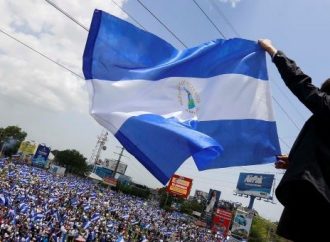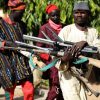A country in severe financial trouble, unable to pay its international bills, poses potential problems for the stability of the international financial system, which the IMF was created to protect. Any member country, whether rich, middle-income, or poor, can turn to the IMF for financing if it has a balance of payments need—that is, if
A country in severe financial trouble, unable to pay its international bills, poses potential problems for the stability of the international financial system, which the IMF was created to protect.
Any member country, whether rich, middle-income, or poor, can turn to the IMF for financing if it has a balance of payments need—that is, if it cannot find sufficient financing on affordable terms in the capital markets to make its international payments and maintain a safe level of reserves.
IMF loans are meant to help member countries tackle balance of payments problems, stabilize their economies, and restore sustainable economic growth. This crisis resolution role is at the core of IMF lending. At the same time, the global financial crisis has highlighted the need for effective global financial safety nets to help countries cope with adverse shocks. A key objective of recent lending reforms has therefore been to complement the traditional crisis resolution role of the IMF with more effective tools for crisis prevention.
Leading by the IMF is not as a development bank
The IMF is not a development bank and, unlike the World Bank and other development agencies, it does not finance projects.
The changing nature of lending
About four out of five member countries have used IMF credit at least once. But the amount of loans outstanding and the number of borrowers have fluctuated significantly over time.
In the first two decades of the IMF’s existence, more than half of its lending went to industrial countries. But since the late 1970s, these countries have been able to meet their financing needs in the capital markets.
The oil shock of the 1970s and the debt crisis of the 1980s led many lower- and lower-middle-income countries to borrow from the IMF.
In the 1990s, the transition process in central and eastern Europe and the crises in emerging market economies led to a further increase in the demand for IMF resources.
In 2004, benign economic conditions worldwide meant that many countries began to repay their loans to the IMF.
As a consequence, the demand for the Fund’s resources dropped off sharply .
But in 2008, the IMF began making loans to countries hit by the global financial crisis The IMF currently has programs with more than 50 countries around the world and has committed more than $325 billion in resources to its member countries since the start of the global financial crisis.
While the financial crisis has sparked renewed demand for IMF financing, the decline in lending that preceded the financial crisis also reflected a need to adapt the IMF’s lending instruments to the changing needs of member countries. In response, the IMF conducted a wide-ranging review of its lending facilities and terms on which it provides loans.
In March 2009, the Fund announced a major overhaul of its lending framework, including modernizing conditionality, introducing a new flexible credit line, enhancing the flexibility of the Fund’s regular stand-by lending arrangement, doubling access limits on loans, adapting its cost structures for high-access and precautionary lending, and streamlining instruments that were seldom used.
It has also speeded up lending procedures and redesigned its Exogenous Shocks Facility to make it easier to access for low-income countries. More reforms have since been undertaken, most recently in November 2011.
Lending to preserve financial stability
Article I of the IMF’s Articles of Agreement states that the purpose of lending by the IMF is “…to give confidence to members by making the general resources of the Fund temporarily available to them under adequate safeguards, thus providing them with opportunity to correct maladjustments in their balance of payments without resorting to measures destructive of national or international prosperity.”
In practice, the purpose of the IMF’s lending has changed dramatically since the organization was created. Over time, the IMF’s financial assistance has evolved from helping countries deal with short-term trade fluctuations to supporting adjustment and addressing a wide range of balance of payments problems resulting from terms of trade shocks, natural disasters, post-conflict situations, broad economic transition, poverty reduction and economic development, sovereign debt restructuring, and confidence-driven banking and currency crises.
Today, IMF lending serves three main purposes.
First, it can smooth adjustment to various shocks, helping a member country avoid disruptive economic adjustment or sovereign default, something that would be extremely costly, both for the country itself and possibly for other countries through economic and financial ripple effects (known as contagion).
Second, IMF programs can help unlock other financings, acting as a catalyst for other lenders. This is because the program can serve as a signal that the country has adopted sound policies, reinforcing policy credibility and increasing investors’ confidence.
How leading by the IMF can help prevent crisis.
Third, IMF lending can help prevent crisis. The experience is clear: capital account crises typically inflict substantial costs on countries themselves and on other countries through contagion. The best way to deal with capital account problems is to nip them in the bud before they develop into a full-blown crisis.
Conditions for lending
When a member country approaches the IMF for financing, it may be in or near a state of economic crisis, with its currency under attack in foreign exchange markets and its international reserves depleted, economic activity stagnant or falling, and a large number of firms and households going bankrupt. In difficult economic times, the IMF helps countries to protect the most vulnerable in a crisis.
The IMF aims to ensure that conditions linked to IMF loan disbursements are focused and adequately tailored to the varying strengths of members’ policies and fundamentals. To this end, the IMF discusses with the country the economic policies that may be expected to address the problems most effectively.
The IMF and the government agree on a program of policies aimed at achieving specific, quantified goals in support of the overall objectives of the authorities’ economic program. For example, the country may commit to fiscal or foreign exchange reserve targets.
The IMF discusses with the country the economic policies that may be expected to address the problems most effectively. The IMF and the government agree on a program of policies aimed at achieving specific, quantified goals in support of the overall objectives of the authorities’ economic program. For example, the country may commit to fiscal or foreign exchange reserve targets.
Loans are typically disbursed in a number of installments over the life of the program, with each installment conditional on targets being met. Programs typically last up to 3 years, depending on the nature of the country’s problems, but can be followed by another program if needed. The government outlines the details of its economic program in a “letter of intent” to the Managing Director of the IMF. Such letters may be revised if circumstances change.
For countries in crisis, IMF loans usually provide only a small portion of the resources needed to finance their balance of payments. But IMF loans also signal that a country’s economic policies are on the right track, which reassures investors and the official community, helping countries find additional financing from other sources.
Main lending facilities
In an economic crisis, countries often need financing to help them overcome their balance of payments problems. Since its creation in June 1952, the IMF’s Stand-By Arrangement (SBA) has been used time and again by member countries, it is the IMF’s workhorse lending instrument for emerging market countries.
Rates are non-concessional, although they are almost always lower than what countries would pay to raise financing from private markets. The SBA was upgraded in 2009 to be more flexible and responsive to member countries’ needs. Borrowing limits were doubled with more funds available up front, and conditions were streamlined and simplified. The new framework also enables broader high-access borrowing on a precautionary basis.
The Flexible Credit Line (FCL) is for countries with very strong fundamentals, policies, and track records of policy implementation. It represents a significant shift in how the IMF delivers Fund financial assistance, particularly with recent enhancements, as it has no ongoing (ex post) conditions and no caps on the size of the credit line.
The FCL is a renewable credit line, which at the country’s discretion could be for either 1-2 years, with a review of eligibility after the first year. There is the flexibility to either treat the credit line as precautionary or draw on it at any time after the FCL is approved.
Once a country qualifies (according to pre-set criteria), it can tap all resources available under the credit line at any time, as disbursements would not be phased and conditioned on particular policies as with traditional IMF-supported programs. This is justified by the very strong track records of countries that qualify to the FCL, which give confidence that their economic policies will remain strong or that corrective measures will be taken in the face of shocks.
The Precautionary and Liquidity Line (PLL) builds on the strengths and broadens the scope of the Precautionary Credit Line (PCL). The PLL provides financing to meet actual or potential balance of payments needs of countries with sound policies, and is intended to serve as insurance and help resolve crises.
It combines a qualification process (similar to that for the FCL) with focused ex-post conditionality aimed at addressing vulnerabilities identified during qualification. Its qualification requirements signal the strength of qualifying countries’ fundamentals and policies, thus contributing to consolidation of market confidence in the country’s policy plans.
The PLL is designed to provide liquidity to countries with sound policies under broad circumstances, including countries affected by regional or global economic and financial stress.
The Rapid Financing Instrument (RFI) provides rapid and low-access financial assistance to member countries facing an urgent balance of payments need, without the need for a full-fledged program. It can provide support to meet a broad range of urgent needs, including those arising from commodity price shocks, natural disasters, post-conflict situations and emergencies resulting from fragility.
The Extended Fund Facility is used to help countries address balance of payments difficulties related partly to structural problems that may take longer to correct than macroeconomic imbalances. A program supported by an extended arrangement usually includes measures to improve the way markets and institutions function, such as tax and financial sector reforms, privatization of public enterprises.
The Trade Integration Mechanism allows the IMF to provide loans under one of its facilities to a developing country whose balance of payments is suffering because of multilateral trade liberalization, either because its export earnings decline when it loses preferential access to certain markets or because prices for food imports go up when agricultural subsidies are eliminated.
Lending to low-income countries
To help low-income countries weather the severe impact of the global financial crisis, the IMF has revamped its concessional lending facilities to make them more flexible and meet increasing demand for financial assistance from countries in need. These changes became effective in January 2010.
Once additional loan and subsidy resources are mobilized, these changes will boost available resources for low-income countries to $17 billion through 2014. To ensure resources are available for lending to low-income countries beyond 2014, the IMF approved an additional $2.7 billion in remaining windfall profits from gold sales as part of a strategy to make lending to low-income countries sustainable.
Three types of loans were created under the new Poverty Reduction and Growth Trust (PRGT) as part of this broader reform: the Extended Credit Facility, the Rapid Credit Facility and the Standby Credit Facility.
The Extended Credit Facility (ECF) provides financial assistance to countries with protracted balance of payments problems. The ECF succeeds the Poverty Reduction and Growth Facility (PRGF) as the Fund’s main tool for providing medium-term support LICs, with higher levels of access, more concessional financing terms, more flexible program design features, as well as streamlined and more focused conditionality.
The Rapid Credit Facility (RCF) provides rapid financial assistance with limited conditionality to low-income countries (LICs) facing an urgent balance of payments need. The RCF streamlines the Fund’s emergency assistance, provides significantly higher levels of concessionally, can be used flexibly in a wide range of circumstances, and places greater emphasis on the country’s poverty reduction and growth objectives.
The Standby Credit Facility (SCF) provides financial assistance to low-income countries (LICs) with short-term balance of payments needs. It provides support under a wide range of circumstances, allows for high access, carries a low interest rate, can be used on a precautionary basis, and places emphasis on countries’ poverty reduction and growth objectives.
Several low-income countries have made significant progress in recent years toward economic stability and no longer require IMF financial assistance. But many of these countries still seek the IMF’s advice, and the monitoring and endorsement of their economic policies that comes with it. To help these countries, the IMF has created a program for policy support and signaling, called the Policy Support Instrument.
Debt relief
In addition to concessional loans, some low-income countries are also eligible for debts to be written off under two key initiatives.
The Heavily Indebted Poor Countries (HIPC) Initiative, introduced in 1996 and enhanced in 1999, whereby creditors provide debt relief, in a coordinated manner, with a view to restoring debt sustainability; and
The Multilateral Debt Relief Initiative (MDRI), under which the IMF, the International Development Association (IDA) of the World Bank, and the African Development Fund (AfDF) canceled 100 percent of their debt claims on certain countries to help them advance toward the Millennium Development Goals.


















Leave a Comment
Your email address will not be published. Required fields are marked with *